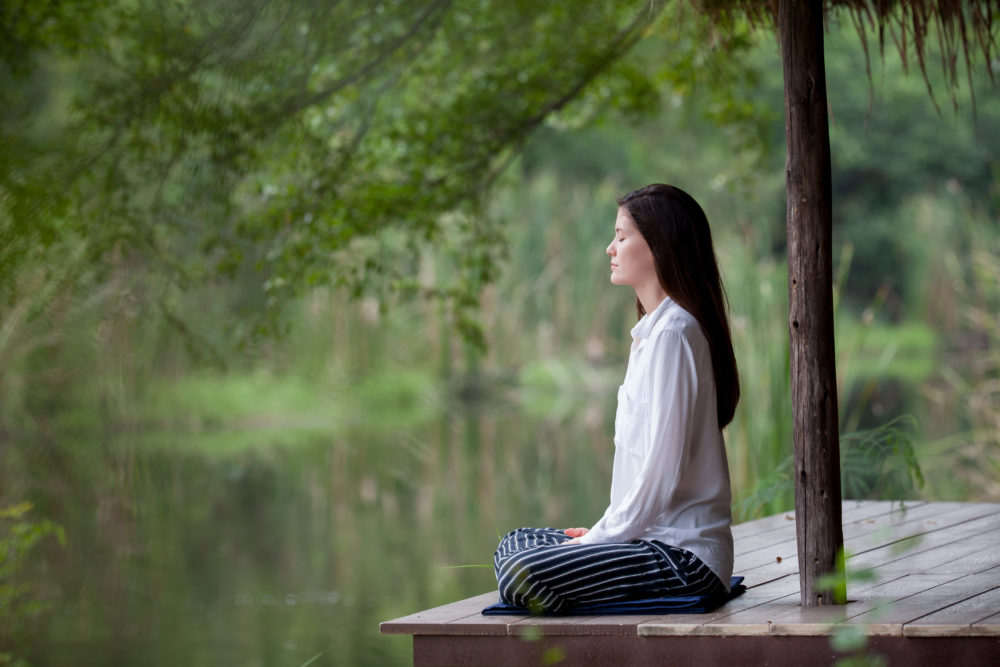This article was originally published on May 5, 2017.

Practicing yoga requires our focus to bring harmony to the physical pose (asana) and the breath (pranayama). Pranayama represents a separate limb of yoga and helps to maintain the body and the mind during practice. Just like each asana has different benefits, each pranayama exercise also has different benefits.
When I learn a new pranayama exercise on the mat, I find myself taking it off the mat very quickly. We can control our breathing when we are practicing yoga, sitting on the bus, or having a conversation with another person. And by using the appropriate exercise, we can drastically change our mood, ability to communicate, and physical response to our situation.
Below, I will explain four different breath techniques that I use when I need to calm down and bring awareness to my body. Try any of these techniques out when you are feeling stressed. I chose these four in particular because each breath may appeal to different types of learners and thinkers. (For example, nodi shodhana pranayama may work best for someone who benefits from physical connection and touch. Visual learners may enjoy adding visualization into their pranayama.)
If you would like to practice incorporating these first two techniques into a physical practice, I have posted a YouTube video with an explanation for Krama and Nodi Shodhana, before and after a gentle vinyasa flow.
- Krama Breath (Also Called “Stair Step” Breath) – This practice helps you follow your breath through a series of steps in your body. You can practice this breath lying down or sitting up. You may place your hands by your side, on your thighs, or place one hand on your heart and the other on your belly. To begin, exhale the air out of your lungs. Fill your chest for a count of two, and then fill your belly for a count of two. Exhale from your belly for a count of two, and exhale from your chest for a count of two. Repeat this process, lengthening your inhales and exhales if you would like. Keep your inhales and exhales equal. If you feel comfortable with this breath, expand the number of “steps” by breathing into your upper chest, lower chest, and your belly.
- Nodi Shodhana (Also Called “Alternate Nostril” Breath) – Focusing on one side of the body at a time brings welcome unity between the two. Sit up tall, exhale completely, and place your right thumb on your right nostril. Inhale through your left nostril, and when you are full, release your right thumb and place your right pinky finger on your left nostril. Exhale through your right nostril, inhale through your right nostril, switch fingers, and exhale through your left nostril. Continue until you feel balanced.
- Sitali (Also Called “Cooling” Breath) – This breath takes “cooling” to a more literal level; it allows you to take in cool air that quells hunger and thirst. It is best practiced in warmer weather to cool your body temperature. Sit up tall, and begin to calmly breathe through your mouth. Roll your tongue so that it makes a visible “O” or “U.” Leave a small bit of your tongue sticking outside of your lips. Inhale through your mouth, as if you were sipping through a straw. Focus on the cold feeling on your tongue. When you are full, gently close your lips and exhale through your nostrils. Repeat.
- Breathing Visualization – Simple visualization can be paired with breath to begin practicing meditation. This breathing technique can be practiced lying down, sitting up, sitting on an airplane, or just when you need a quiet moment to fill yourself up with positive intentions. Close your eyes. Begin to gently inhale through your nostrils and picture the air filling your nostrils and body with light. This light can be any color, brightness, or image…whatever makes you feel calm. Picture this light filling every area of your body, from your fingertips to your toes. As you exhale, picture yourself pushing stress, tension, and toxins out of your body through the tips of your fingers, toes, out the crown of your head, etc. I like to picture this negative energy as a dark dust cloud, but again, use whatever image works best for you. Continue this breathing visualization until you are completely filled with light and rid of darkness. Smile.
These are just a few of my favorite breath techniques. What type of breaths do you like to calm you down? Do you add mudras or have a mantra that works well? Let me know in the comments!
Also by Megan: Who Cares If You Go Alone? 4 Reasons to Say ‘Yes’ To Solo Adventures
Related: 3 Yoga Breathing Exercises for Stress Relief
4 Pilates Exercises For Deep Breathing (Video)
Get more like this—Subscribe to our daily inspirational newsletter for exclusive content!
__
Photo: Unsplash




